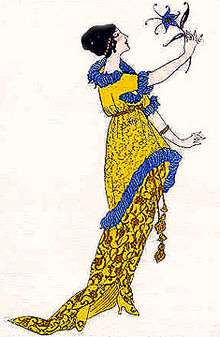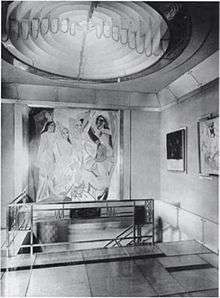Jacques Doucet (fashion designer)

Jacques Doucet (French pronunciation: [ʒak du.sɛ]) (1853–1929) was a French fashion designer and art collector. He is known for his elegant dresses, made with flimsy translucent materials in superimposing pastel colors.
Doucet was born in Paris in 1853 to a prosperous family whose lingerie and linens business, Doucet Lingerie, had flourished in the Rue de la Paix since 1816. In 1871, Doucet opened a salon selling ladies' apparel. An enthusiastic collector of eighteenth-century furniture, objets d'art, paintings and sculptures, many of his gowns were strongly influenced by this opulent era. Beginning in 1912, the fashions of Jacques Doucet were illustrated in the fashion magazine La Gazette du Bon Ton with six other leading Paris designers of the day – Louise Chéruit, Georges Doeuillet, Jeanne Paquin, Paul Poiret, Redfern & Sons, and the House of Charles Worth. His most original designs were those he created for actresses of the time. Cécile Sorel, Rejane and Sarah Bernhardt (for whom he designed her famous white costume in L'Aiglon) all often wore his outfits, both on and off the stage. For the aforementioned actresses he reserved a particular style, one which consisted of frills, sinuous curving lines and lace ruffles the colors of faded flowers. Doucet was a designer of taste and discrimination who valued dignity and luxury above novelty and practicality, and gradually faded from popularity during the 1920s.

Several years after World War I, in 1927, Cubists Joseph Csaky, Jacques Lipchitz, Louis Marcoussis, Henri Laurens, the sculptor Gustave Miklos, and others collaborated in the decoration of a Studio House, rue Saint-James, Neuilly-sur-Seine. The hôtel particulier, owned by Doucet was designed by the architect Paul Ruaud. Laurens designed the fountain, Csaky designed Doucet's staircase,[1] Lipchitz made the fireplace mantel and Marcoussis created a Cubist rug.[2][3][4]

A collector of art and literature throughout his life, by the time of his death he had a collection of Post-Impressionist and Cubist paintings, including Les Demoiselles d'Avignon, which he bought direct from Picasso's studio, as well as two libraries of manuscripts by contemporary writers, both of which he left to the French nation. Doucet donated his collection of art books and research to the University of Paris when he died in 1929. The University created in his honour the Bibliothèque littéraire Jacques-Doucet.[5] Francois Chapon wrote a book titled C'etait Jacques Doucet about the life and work of the fashion designer.[6]
References
- ↑ Joseph Csaky's staircase in the home of jacques Doucet. Books.google.es. Retrieved 2012-12-18.
- ↑ Aestheticus Rex (2011-04-14). "Jacques Doucet's Studio St. James at Neuilly-sur-Seine". Aestheticusrex.blogspot.com.es. Retrieved 2012-12-18.
- ↑ ''The Modernist Garden in France'', Dorothée Imbert, 1993, Yale University Press. Books.google.es. Retrieved 2012-12-18.
- ↑ Joseph Csáky: A Pioneer of Modern Sculpture, Edith Balas, 1998, p. 5. Books.google.es. Retrieved 2012-12-18.
- ↑ "Historique de la bibliothèque" (in French). Sorbonne. Retrieved 3 March 2013.
- ↑ Chapon, François. C'etait Jacques Doucet. Fayard.